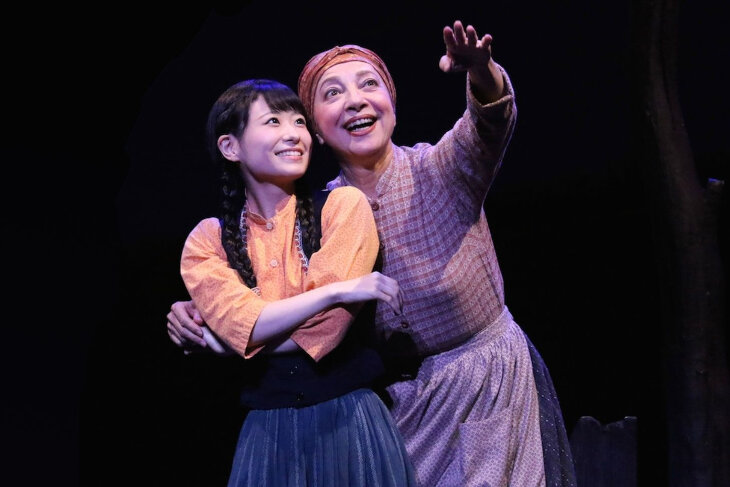 Vampire Weekend's Surprising Jewish Stories
Vampire Weekend's Surprising Jewish Stories


5 min read
The Japanese people, known for their respect for heritage, saw a kindred spirit in Tevye as he grappled with the inevitable clash between the old ways and the allure of progress.
In Tokyo, sellout crowds are flocking to Yane No Ue No Baiorin-hiki, Japanese for Fiddler on the Roof, the most successful musical in Japanese history. Singing the words to L’Chaim and If I Were a Rich Man in Japanese, there is something about this play that transcends borders and language.
The musical, adapted from the book of short stories "Tevye and his Daughters and Other Tales" by Sholom Aleichem, was received with glowing reviews in 1964 and went on to be the longest-running Broadway musical at the time. The emotional story of a family’s battle with modernity and antisemitism won the hearts of American theater-goers and people across the country. The popular musical has sparked five Broadway revivals in addition to a massively successful film adaptation in 1971, directed by Norman Jewison (who was not Jewish).
How did Fiddler become a huge hit in Japan, of all places?
While Japan may not be the first country that comes to mind when you think of Jewish heritage, you'd be surprised by the intertwining threads of tolerance and appreciation woven into their history. Sporting a minor Jewish community of around 2,000 that originated when the first Jewish settlers arrived in Yokohama in the 1850s and started the first synagogue in the area. Japan has had a Jewish population for almost two centuries.
“L’chaim—To Life” from a Japanese performance of Fiddler on the Roof. pic.twitter.com/B0MhjjuhKO
— Historicus Hasidicus (@hasidicus) July 7, 2022
However, Japan's ties with Judaism run deeper. During World War II, when much of the world turned its back on Jewish communities, Japan became somewhat of a safe haven. Chiune Sugihara issued transit visas to thousands of Jews, enabling them to escape Nazi persecution and find refuge in Japan or other countries. His act of compassion and bravery served as a testament to the importance of embracing diversity.
One of the factors that led to such tolerance was that during the Russian Civil War, Russians introduced Japanese soldiers to “The Protocols of the Elders of Zion,” one of the seminal works of modern antisemitism and the source of the idea that Jews control the world.
This led to a strong pro-Jewish sentiment among Japanese government leaders, who mostly thought it would be wise to win over such a powerful group. Ironically enough, the same troops who were first introduced to the book later devised a scheme to bring a great deal of Jews to Manchuria and took in significant numbers of Jewish refugees during the Holocaust, expecting that it would help them improve their financial situation. The officials who promoted these schemes usually invoked "protocols" in their arguments.

Fast forward to the post-war era, and Japan's interest in Jewish culture began to come into full focus. As the first amateur productions of Fiddler on the Roof started to be shown in Japan, the enchanting melodies and heartwarming stories resonated with the Japanese audience, who found parallels between their own traditions and the trials and tribulations of Tevye and his family. And it was only a matter of time before it became a cultural phenomenon.
Japan’s Fiddler on the Roof hits all the same notes as the original does. The songs have the same blissful melodies and the emotional ending breaks your heart.
Japan was the very first country to do a non-English production of the acclaimed show, and when the producer of the show visited Japan to see how it was coming along, he shared, “I was very nervous about how it would be received in a completely foreign environment. I got there during the rehearsal period, and the Japanese producer asked me, ‘Do they understand this show in America?’ And I said, ‘Yes, of course, we wrote it for America. Why do you ask?’ And he said, ‘Because it’s so Japanese.’”
It’s hard to see many parallels between the Japanese and the Jews other than an affinity for putting salmon on pretty much everything. What makes Fiddler so Japanese?

The popularity of Fiddler on the Roof in Japan can be attributed to its timeless and relevant themes of love, family, and the struggle to preserve tradition in the face of a changing world. The Japanese people, known for their respect for heritage, saw a kindred spirit in Tevye as he grappled with the inevitable clash between the old ways and the allure of progress. They connected to the father-daughter drama and the difficulties Tevye experienced with each of his daughters.
The other significant factor in Fiddler’s success was its take on Westernization. Japan, also a culture that grappled with the same questions, was learning to deal with the new perception of arranged marriages and the rejection of tradition. The same drastic changes that Jews experienced in 20th-century Russia occurred in Japan at the same time: the shift from the shogun to the emperor, naming Tokyo as its capital after centuries it being Kyoto, and the creeping influence of American culture seeping in.
So, it’s not hard to see why Fiddler struck such a chord in Japan. As Jeremy Dauber notes in his book The Worlds of Sholem Aleichem, Fiddler became “a free-floating symbol, an Everylens for talking about universal challenges to tradition.”
Fiddler presents the tensions of assimilation and the fight to maintain our Jewish identities in the face of modernity. The themes of grappling with modernity and holding on to tradition have made Fiddler resonate with audiences from all over the world in a way that no other play has been able to. As Fiddler on the Roof continues to captivate Japanese audiences, it serves as a bridge between cultures, fostering understanding and celebrating the shared values of resilience and family bonds. It's a testament to the power of art and theater as a medium that goes beyond language gaps or cultural differences.
